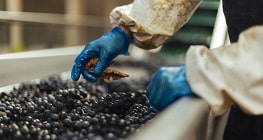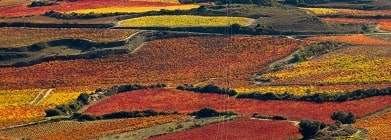The new Viñedo Singular geographical indication designates wines from particular vineyards or estates and is directly linked to the terroir, which it aims to identify and valorise on the label, tied to the quality requirement that they be excellent wines.
Viñedo Singular
Requirements
- Grapes coming exclusively from a plot or plots that constitute the Viñedo Singular.
- Vinification, ageing, storage and bottling within the same winery.
- Minor geographical unit that can comprise a single or several cadastral plots.
- Minimum age of the vineyard:
- Evidence, by means of any legally valid title, of having had the exclusive use of the production of the viñedo singular for a minimum period of 10 years without interruption.
- Maximum production: 5,000 kg/ha for red varieties and 6,922 kg/ha for white varieties.
- Maximum grape-to-wine ratio: 65%.
- Specific Grape Grower’s Card.
Growing practices
- The viñedo singular must be balanced and have limited vigour. During the grape ripening stage, canopy growth should cease completely.
- Only a single tipping is permitted.
- Harvested manually.
Documentary control
- Before 30 June a statement of intention to make a Viñedo Singular wine.
a. Statement of amount of wine made.
b. Specific classification - Differentiated wine movement.
a. Differentiated back label.
Physical control
- Traceability
- Specific production controls in all vineyards from 1 July to harvest, production changes not being allowed later.
- Canopy development controls.
- Specific wine stocks.
- Specific classification verification.
- Control of wine movements.
- Control of labelling and use of back labels.
- Control of batches of approved wine Excellent rating.
- Submission of report.
- Recognition of the ministry.
- Exclusive brand.
Ejemplo de etiqueta de Viñedo Singular

Vinos de Municipio
As in the case of wines from a specific zone, the right to use the name of the town on the label has been recognised for almost 20 years; more precisely, since 1999. The new regulation will provide more visibility to this geographical indication.
Requirements
- Grapes coming exclusively from the municipality.
- Vinification, ageing and bottling within the municipality.
EXCEPTION: Up to 15% from bordering municipalities and long-standing ties with the vineyard dating back at least ten years.
Documentary control
- Prior communication to CB.
- Statement of amount of wine made.
- Specific classification.
- Differentiated wine movement.
- Back label with specific code.
Physical control
- Traceability.
- Specific wine stocks.
- Specific classification verification.
- Control of wine movements.
- Control of labelling and use of back labels.
- Control of batches of approved wine.
Ejemplo de etiqueta de Vinos de Municipio

Vinos de Zona
Designation Regulations recognise the existence of three sub-areas or sub-zones since 1970: Rioja Alavesa, Rioja Alta and Rioja Baja (now called Rioja Oriental). Under the new zona (zone) term, the Control Board has updated the regulations on the visibility of this indication on wine labels which were implemented in 1998.
Requirements
- Grapes coming exclusively from the zone.
- Vinification, ageing and bottling within the zone.
EXCEPTION: Up to 15% from bordering municipalities and long-standing ties with the vineyard dating back at least ten years.
Documentary control
- Prior communication to CB.
- Statement of amount of wine made.
- Specific classification.
- Differentiated wine movement.
- Back label with specific code.
Physical control
- Traceability.
- Specific wine stocks.
- Specific classification verification.
- Control of wine movements.
- Control of labelling and use of back labels.
- Control of batches of approved wine.
Ejemplo de etiqueta de Vinos de Zona















